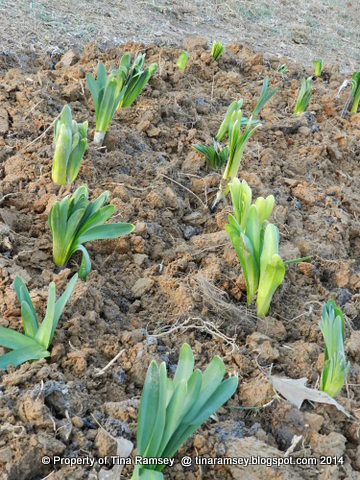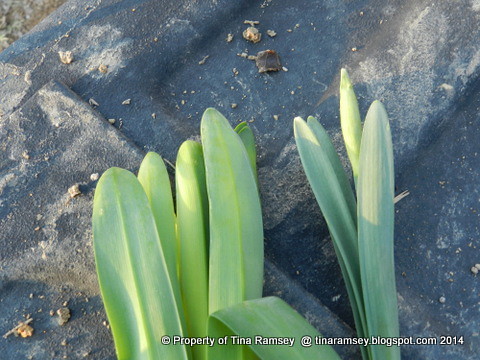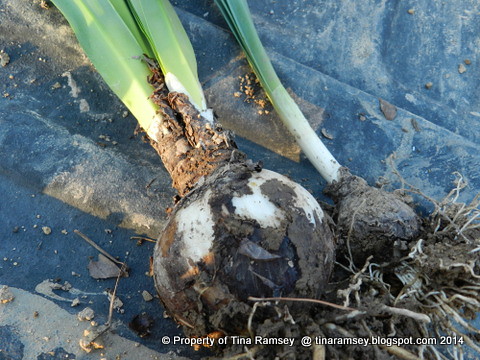
As I have been moving my garden I am learning a great deal about mature plants and their reaction to being disturbed. I have had a great deal of experience with moving plants and marvel at just how well plants adapt both above ground and below ground. The way I move my garden is to dig like plants. Recently my dig saw me digging up all of my Lycoris squamigera, aka Pink or Naked Ladies, or Resurrection Lilies. I dug over 150 and the job was ever so rewarding. Especially when you look to buy these expensive bulbs online and find they start at the very pricey amount of $5 per bulb! That means I dug about $800 worth of bulbs. I think these will become part of stock when I open a nursery on my land--one day.
Coincidentally I am also digging daffodils (Narcissus species) because these bulbs emerge the same time as the Lycoris bulbs. The foliage of daffodils and Pink lady bulbs not only emerges at about the same time (Pink lady bulbs comes up a wee bit later than daffodil foliage) but the foliage of the two kinds of bulbs is very similar. If you are not attuned to the difference you might be quick to think that Pink Lady foliage is daffodil foliage. You will be sorely disappointed when that foliage produces no blooms in the spring time. Let me outline the differences of the two bulbs I observed in my garden.

Pink Lady foliage is rounded and generally larger than daffodil foliage. You can clearly see this when looking at the tips of the foliage of the Pink Lady bulb (on the left) and the 'Ice Follies' daffodil (on the right. I purposely chose a large flowering daffodil for comparison purposes to the Pink Lady foliage. Obviously daffodil foliage is varied but generally all daffodil bulbs produce a pointed leaf whereas the Pink Lady foliage will be rounded to oblong on the end of the leaf.

Another huge difference is the size of the bulbs. Pink Lady bulbs can get quite large when mature. I dug a wide variety of sizes of Pink Lady bulbs. They ranged in size from a diameter of six inches to a diameter of 1/2 inch. The smaller bulbs were generally offsets or bulbs that had not been in place for more than one or two years. You can kind of determine if a bulb is a daffodil or Pink Lady simply looking at the size, but if in doubt there is one very telling clue that can help you decide the difference. You can see it in the above and below pictures.

The major difference is that the Pink Lady bulbs will simultaneously put out multiple leaf stalks whereas the daffodil bulbs will put out only one leaf stalk per bulb. The bulb on the right looks like it has multiple leaf stalks but there are actually two bulbs there that are attached. The Pink Lady bulb in the center has many leaf stalks but only one bulb. Additionally, the leaves that emerge from the Pink Lady bulbs are all fairly uniform in size, color, and texture whereas daffodil foliage may emerge at different times and be different lengths.

Another key difference in the bulbs is the size of the roots. The Pink Lady bulbs have larger and fatter roots. These roots can extend to 4" or more. The daffodils have roots that are finer. Sometimes when daffodils grow abundantly and get crowded the bulbs can develop contractile roots. These contractile roots look similar to the Pink lady roots in that they are large, but these roots will also be joined by regular fine roots so they are not to be confused with the Pink Lady roots. The contractile roots are to pull the bulb down deeper in to the soil. I have found this phenomena quite frequently in my efforts to move my garden but simply haven't taken a picture yet.
A little note on designing with Lycoris squamigera bulbs. In days past it seemed the likely spot for these bulbs was the lawn. Even today I see large groups growing in the lawn. I think perhaps this was because the foliage would die down by the time the lawn needed to be mowed therefore not causing problems in the lawn. Plus, since the foliage died down if you planted these bulbs in a garden you would therefore have a blank spot unless you over planted the bulb with another plant. You have to chose carefully if you decide to over plant these bulbs. I think the lawn is about the worst place for these bulbs because inevitably the person mowing the lawn will not be paying attention in early August when the flower scapes emerge. And guess what will happen? Your flowers will be mowed down and you will never get to enjoy the beautiful and fragrant flowers. Like all flowers I plant in my garden I tend to mass my flowers. These bulbs look great in natural settings in open shade or full sun-massed in groups of five or more. Be sure to space the bulbs at least 6"-8" apart. I like to plant mine where I can enjoy their summer show but where they will not interfere with the garden looks at other times of the year. I have transplanted about 100 of these beautiful bulbs to a 14' diameter round garden on my farm that surrounds a 'Calloway' crabapple. I planted a double row of them in the outer two feet of the circle. The flowers will make a spectacular edging when they bloom later this summer. I plan to plant mouse eared coreopsis over my bulbs or I can easily plant annuals over the bulbs this spring. A favorite combination of mine is to plant sprigs of 'Diamond Frost' euphorbia over these bulbs. 'Diamond Frost' is an awesome annual in our area and looks fabulous with these Pink Lady blooms during the summer. In my case I am leaning toward the mouse eared coreopsis because I am trying to reduce maintenance in the garden and planting annuals each year can be labor intensive. I have read online that you can over plant Lycoris bulbs with things like vinca or ivy. I would never ever recommend this because those two vines will form such a solid mass that the Lycoris will have a hard time popping through the foliage, not to mention both of these vines tend to take over. They are both no nos in my garden and garden designs. Other perennials I think you could successfully over plant Lycoris bulbs with include: perennial geraniums (Geranium species), coreopsis (lower growing types), and perhaps echinacea....
in the garden....
I learn so much about gardening from your blog and admire your hard work and vision.
ReplyDeleteCool to see them side by side as I don't grow the pink ladies.
ReplyDeleteCan't wait to see these blooming!
ReplyDeleteWow, those are massive buls you've got there! :-) So interesting to see the differences. Many thanks.
ReplyDeleteGreetings from London.
This is really helpful information, Tina! I never thought about Lycoris and daffodils being so similar, but I have only a few Lycoris, and they are planted in a place where no other bulbs are. They were here when we moved here, and I do remember, though, that first year seeing the foliage and wondering why they didn't bloom in the spring:) I had no idea the bulbs were so expensive--can they be divided like other bulbs? If they can, I'd like to spread them around a little, but I certainly won't plant them in the lawn--Mr. Lawnmower Man definitely wouldn't notice them until it was too late:)
ReplyDeleteI just call them all daffodils! I love their cheery yellow dancing faces in the warm spring breeze....
ReplyDeleteThis post brought a reminiscent smile to me as I recalled my novice first year garden experience in our house. The daffodils were spectacular in several gardens. Some didn't bloom though, I thought and then later that summer surprise! Strange stalks and then beautiful pink flowers popping open all over.... Oh to be that young again...:)
ReplyDeletei moved to my new house in Aug had no idea they were there til i was raking leaves the other day. so i posted them on plant id groups trying to figure out what they were. they are growing in the grass like you said so last year Im sure we mowed over them.. my question is can they be moved now & will they still bloom or should i leave them? Im in Oklahoma zone 7b
ReplyDeleteYes Kim! Move them now. Older more traditional gardeners planted lycoris squamigera in the grass. But, to the uninitiated you will never see those bulbs bloom because they will be mowed down during their bloom time. Both narcissus and the pink ladies can be moved. Plant them where they will not be disturbed by mowers or other perennials. Be sure to give them space as the bulbs will increase with time. Good luck! I'm doing the same right now.
DeleteP.S. They should both still bloom this year but it will depend upon the divisions for the lycoris. Larger bulbs may have enough reserves so perhaps not all will bloom. But next year look out!
DeleteWe have lived in our house in Pittsburgh, Pennsylvania for about 26 years. There was an existing patch of narcissus when we bought the house. About 10 years ago, we divided these bulbs and planted some in another area of the front yard. About five years ago, a pink lady appeared in the new patch we planted. The following year, one grew in the original patch of narcissus. Now, every year since, the pink ladies grow in both patches and appear to be spreading. We have never bought or planted any new bulbs in either location. My question is where did the pink ladies come from? Could they have laid dormant in the soil for twenty years or so until we dug up the first narcissus bed? Mark
ReplyDeleteHi Mark, you did not say if the narcissus bloomed or not. If not perhaps it was pink ladies all along. If the narcissus bloom along with the pink lady it is likely the bulbs were planted along with the narcissus. Old time gardeners often planted narcissus and punk ladies together. I see it all the time in Tennessee because the bulbs still come up each spring. They are often so crowded they don't bloom tho-neither narcissus or pink ladies. Consider it a very lucky find and enjoy them!
DeleteMark, We live in Maine and I too, never planted Lycoris squamigera (Pink or Naked Lady) in our garden. But, about 5 yrs ago one appeared and now there are three to four clumps in new locations - actually different garden beds. Initially I thought the plants must spread by seed, but now wondering if the bulbs, or portions thereof, are moved by rodents. I've just ripped them all out and put them in a garbage bag and plan to take them to the landfill. Perhaps appropriate for some gardens, they color clash in ours. Chris
ReplyDeleteChris, It is interesting to hear that someone else has had this experience also. To respond to Tina's comment, the daffodils, which are the type with white petals and small yellow cups, have bloomed wonderfully for the past 25 years. Until the naked/pink ladies bloomed about five years ago, I may not have recognized their distinctive foliage if they were there all along, but it seems rather strange that the pink ladies would not have bloomed for the first twenty years. I thought maybe they arose somehow by cross pollinating with the daffodils since they are both (I think) in the amaryllis family. However, I could not find any explanation on the internet as to how they mysteriously appeared, thus my sharing on this blog. We do have a lot of chipmunks, so if I can give them credit, they have finally done something useful other than being cute. Now that I recognize the pink lady foliage (and I did dig up a bulb this spring and it was substantially larger than the daffodil bulbs, as shown in the photos above), it appears that there are now about five or six locations of pink ladies in two different flower beds. I am glad that they showed up. They look very nice among the astilbe and hostas after the daffodil foliage dies back. Chris, too bad you couldn't gift the bulbs to a neighbor. I have acquired some other nice perennials trading with neighbors. However, none of the trades have ended up in the daffodil beds. Mark
DeleteMark, We live in Maine and I too, never planted Lycoris squamigera (Pink or Naked Lady) in our garden. But, about 5 yrs ago one appeared and now there are three to four clumps in new locations - actually different garden beds. Initially I thought the plants must spread by seed, but now wondering if the bulbs, or portions thereof, are moved by rodents. I've just ripped them all out and put them in a garbage bag and plan to take them to the landfill. Perhaps appropriate for some gardens, they color clash in ours. Chris
ReplyDelete